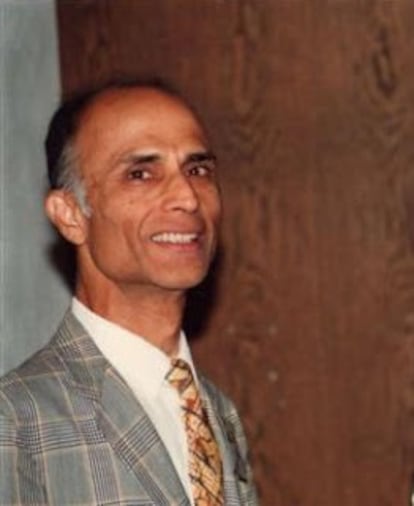One hundred years of the mathematician who explored infinite symmetries
The works of Harish-Chandra, born on October 11, 1923, originally inspired by physics, have had a great impact on pure mathematics

Today, October 11, marks 100 years since the birth of Harish-Chandra, one of the most important Indian mathematicians in history. Trained as a physicist under the tutelage of two Nobel Prize winners, he began his work in mathematics studying the space-time symmetries of Einstein’s theory of relativity. His later, purely mathematical works — on the theory of infinite-dimensional representations of so-called semisimple groups — have been extremely influential. They were one of the main sources of inspiration in the development of the Langlands program, an ambitious roadmap of mathematical research that relates areas such as algebra, number theory, analysis, and geometry.
Harish-Chandra Mehrotra was born in 1923 in Kanpur, northern India. After graduating from the University of Allahabad, he continued his studies in physics at the Indian Institute of Science in Bangalore under the direction of C. V. Raman — Nobel Prize winner in Physics in 1930 — and Homi J. Bhabha.
He immigrated to Cambridge, in the U.K. in 1945, just before Bhabha founded the prestigious Tata Institute of Fundamental Research — where the next generations of Indian mathematicians and physicists would be trained. Shortly after, he moved to the United States, where he spent the rest of his career. Although he had always harbored the desire to have played a greater role in promoting science in India, his poor health and premature death prevented this.
He received his doctorate in physics during his time at the University of Cambridge, under the direction of Paul Dirac — also a Nobel Prize winner in Physics, in 1933 — but, upon completing it, he decided to change his research topic to mathematics. This transfer between disciplines is more common than you might think. Fundamental physics, since the middle of the 20th century, needs increasingly advanced mathematics to be formalized, which is why many physicists who are approaching the frontier of mathematical research decide to go one step further and modify their specialization.
In the case of Harish-Chandra, the logical rigor required in mathematical proofs was also an argument in favor of the leap. While theoretical physicists rely on intuition — which guides their work and allows them to anticipate phenomena before they are verified experimentally and which, according to Harish-Chandra, he lacked — he felt more confident when he could back up his results with a rigorous mathematical argument. Without the required intuition, he thought his physical research could lead him astray.
During his thesis, Harish-Chandra studied the so-called Poincaré group, which is an algebraic construction that captures the space-time symmetries of Einstein’s theory of relativity. In particular, a symmetry group of a given object — for instance, a square — is the set of operations that can be performed on it, without altering its properties. For example, when you rotate the square 90 degrees, it returns to having the same appearance, so this operation is part of the group of symmetries of the square.
When considering the Euclidean plane — that is, the plane together with the notion of distance — any rotation belongs to its group of symmetries, since, when the plane rotates, the distance between any pair of points does not change. However, when you stretch it, the distance between the points will become greater, so this operation does not fall within the group of symmetries of the plane.
In Einstein’s theory of relativity, space-time is considered together with the so-called Minkowski metric — instead of the usual distance. And the Poincaré group is the group of space-time symmetries, that is, all transformations that do not change the Minkowski metric.
In his doctoral thesis, Harish-Chandra studied representations of the infinite-dimensional Poincaré group. A representation of a group in a linear space consists of assigning a linear transformation of that space to each element of the group — that is, a function that meets certain properties — which allows the use of linear algebra techniques in the study of the groups. Linear space can be finite or infinite. In the case of the Poincaré group, it admits certain representations of infinite dimension, which cannot be decomposed as finite representations. Although these are more difficult to handle than finite ones, they are a necessary tool to study certain groups.
As a mathematician, Harish-Chandra studied the infinite representations of other groups, more specifically the so-called semisimple groups, and he was a strong candidate for the Fields Medal in 1958 for his work on them. However, it seems that a member of the jury did not want the medal to be given to two mathematicians from the French Bourbaki group — which he considered both Harish-Chandra and René Thom to be — and it was ultimately Thom who received the award that year. Harish-Chandra was never a member of this group, but his style, with its rigor and attention to detail, was perhaps thought to be closely associated with the famous collective.
After working at Columbia University (New York), he was appointed tenured professor at the Institute for Advanced Studies at Princeton (New Jersey) in 1963. Starting in 1969, he began suffering heart attacks, possibly aggravated by his intense work schedule — his workday extended late into the night. His doctor insisted that he take annual vacations, which he took advantage of to encourage his love of painting — he was a great admirer of Gaugin in particular — and he finally died in 1983 of a heart attack while taking an afternoon walk on the last day of a conference honoring himself and Armand Borel, his friend and collaborator.
Sign up for our weekly newsletter to get more English-language news coverage from EL PAÍS USA Edition
Tu suscripción se está usando en otro dispositivo
¿Quieres añadir otro usuario a tu suscripción?
Si continúas leyendo en este dispositivo, no se podrá leer en el otro.
FlechaTu suscripción se está usando en otro dispositivo y solo puedes acceder a EL PAÍS desde un dispositivo a la vez.
Si quieres compartir tu cuenta, cambia tu suscripción a la modalidad Premium, así podrás añadir otro usuario. Cada uno accederá con su propia cuenta de email, lo que os permitirá personalizar vuestra experiencia en EL PAÍS.
¿Tienes una suscripción de empresa? Accede aquí para contratar más cuentas.
En el caso de no saber quién está usando tu cuenta, te recomendamos cambiar tu contraseña aquí.
Si decides continuar compartiendo tu cuenta, este mensaje se mostrará en tu dispositivo y en el de la otra persona que está usando tu cuenta de forma indefinida, afectando a tu experiencia de lectura. Puedes consultar aquí los términos y condiciones de la suscripción digital.
More information
Archived In
Últimas noticias
The murder of Michele and Rob Reiner: A tale of horrific days in Hollywood
Trump orders a ‘complete blockade of sanctioned oil tankers’ going to and from Venezuela
Not all insomnia is the same: Study identifies five subtypes and paves the way for personalized treatment
The United States designates Clan del Golfo as a foreign terrorist group
Most viewed
- ‘El Limones’ and the growing union disguise of Mexican organized crime
- Christian Louboutin: ‘Young people don’t want to be like their parents. And if their parents wear sneakers, they’re going to look for something else’
- ‘We are dying’: Cuba sinks into a health crisis amid medicine shortages and misdiagnosis
- A mountaineer, accused of manslaughter for the death of his partner during a climb: He silenced his phone and refused a helicopter rescue
- The low-cost creative revolution: How technology is making art accessible to everyone










































